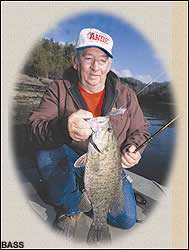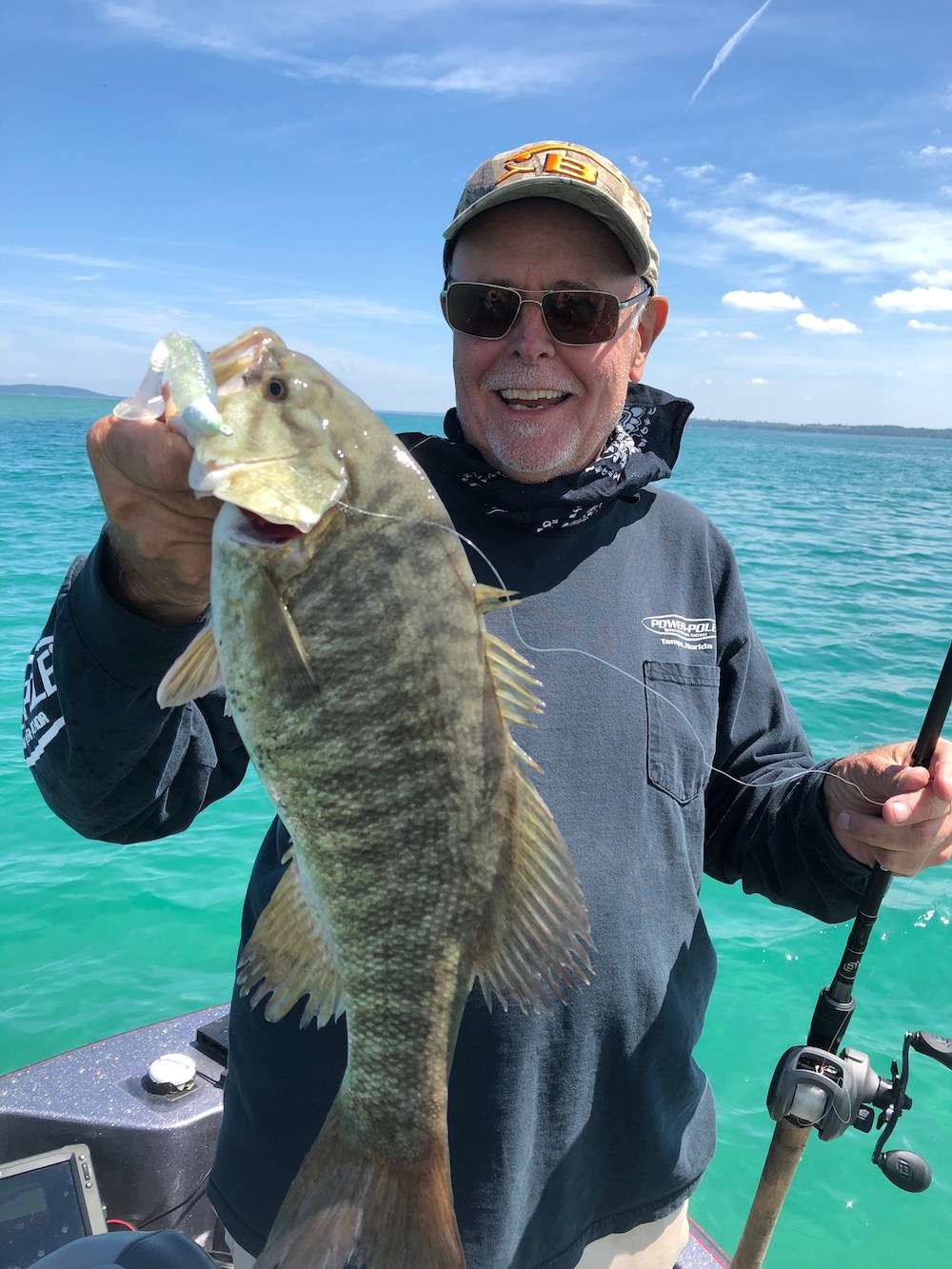
Metal bass lures have been around for decades, yet a surprising number of Bassmasters have either never fished them, or have experimented with them only briefly — and without success. Metal baits are highly dependent upon angler skill and proper techniques, yet information on retrieve methods has been hard to come by. Consequently, legions of otherwise competent bass anglers haven’t a clue how to fish them.
If you’re among the clueless, prepare to get educated in the basics of fishing heavy metal from a master: Dale Hollow Lake guide Fred McClintock. A recent inductee into the National Fresh Water Fishing Hall of Fame, McClintock relies extensively on metal baits for catching big smallmouth, largemouth and spotted bass from this cavernous reservoir on the Tennessee/Kentucky border. If you want to score more strikes, especially in clear, cold water, pay close attention to what Fred has to say.
— Don Wirth
Out of sight, out of mind
The vast majority of my bass clients have never fished a metal lure before they stepped into my boat. But it’s easier to show a total novice how to fish these baits correctly than it is to teach an angler who’s played around with them — the novices haven’t picked up any bad habits with their retrieves. Once they get a strike on a metal bait, they quickly gain confidence in it.. And if they catch a big bass, they’re hooked.
A major reason many bassers never fish metal is that these lures maintain such a low profile — as the adage goes, out of sight, out of mind. Metal baits are expensive and time consuming to manufacture, and have a slimmer profit margin than, say, plastic crankbaits or topwater plugs, which is the reason few big lure companies fool with them. Some of the best metal baits are made by local fishermen in their workshops and sold only through nearby bait shops. A few large lure manufacturers offer metal baits, but they’re seldom promoted heavily, and they are often buried on the last page of their catalogs. Without national advertising and pro angler sponsorship promoting these lures, it’s no wonder most fishermen never think to buy or throw metal.
|
Blade basics
|
|
|
1. Cast to sloping bank. Let sink with rod starting at 11 o’clock (A) then slowly lower rod to nine o’clock (B) as lure falls. Maintain a semislack line.
2. Once lure hits bottom or ledge, lift rod tip back to (A). Bait will vibrate and hop off ledge/bottom.
3. Lower rod tip again as bait falls, reeling in some slack. Repeat.
|
Metal merits
Why fish a metal bait? Here are several compelling reasons:
They sink quickly into the strike zone, a real benefit when fishing deep water, or when bass are suspended.
They are quite compact
for their weight (compare a ¾-ounce crankbait to a ¾-ounce spoon). This makes them more appealing to bass in cold water, when digestion slows and smaller baitfish are preferred.
Metal lures are the only baits that can be cast and retrieved effectively in superdeep water (more than 30 feet). I’ve caught smallmouth bass 70 feet deep on blade baits, and spotted bass 100 feet deep on spoons!
These lures are highly versatile. Some metal styles can be worked conventionally or fished vertically. You can hop a spoon on the bottom and catch bass in 50 feet of water, or skip it over the surface and catch schooling bass.
Styles and applications
Metal bass baits can be divided into four categories:
Blade baits — These razor-thin lures have a fish-shaped body stamped from sheet metal, and a weighted head. They exhibit little or no action when falling, but vibrate frantically when reeled. My favorite blade is the Silver Buddy (www.silverbuddy.com).
Tailspinners — The smallest of the metal lure styles, these have a teardrop or triangular body with a small spinner blade at the tail. Some have an elongated wire at the tail, to which the spinner blade and a second hook covered by marabou dressing are attached. The blade spins both on free-fall and retrieve, creating intense flash and vibration. My favorite tailspinner is the Little Sparky, made by Elmer Taylor (423-263-9551). This bait has a flat belly and minnow-shaped body; it looks exactly like the small shad commonly found in Dale Hollow during the winter months.
Spoons — These baits have no vibration, but plenty of flash. Some have built-in rattles. A spoon is my top lure choice in water below 45 degrees, when bass suspend in open water around baitfish schools. My favorites are the Hopkins Shorty (www.hopkinslures.com) and Acme Sidewinder (www.acmetackle.com).
In-line spinners — I don’t personally use these for reservoir bass fishing, but include them here to give you a complete overview of metal bait styles. They feature a rotating blade on a wire shaft in front of a weighted body that flashes and throbs with a slow, steady retrieve. Some have hair dressing covering the hook. I fish in-lines mainly in river current; Strike King’s In-Spin Elite is a good one (www.strikeking.com).
I use the same tackle for all of these baits: 7-foot medium action St. Croix PC70MF baitcasting rods and Shimano Chronarch and Curado reels spooled with 10- to 14-pound Ande monofilament. In frigid water, a slow speed reel like the old Lew’s BB1 helps prevent you from working metal baits too quickly.
Fishing blade baits
Blades are my bread-and-butter baits for fall and winter smallmouth fishing. They’re deadly when bass are holding on rock banks with a 45 degree slope. I use the ½-ounce Silver Buddy when fishing down to 30 feet, and the ¾-ounce size down to 50 feet. Always use the wire snap that comes with the lure. Tying directly to the bait will cut your line and send your blade into orbit when you cast.
The blade is best fished as a stairstep lure. A 45 degree rock bank is seldom slick, but typically has a series of little ledges or shelves along its slope. Bass hold on these in their preferred depth range, rushing out into open water to grab passing baitfish. If you drop a blade down these steps, sooner or later it’s gonna get eaten. Here’s the easiest way to fish this lure:
- Locate a sloping bank or rocky point and idle around the structure slowly, watching your graph for baitfish or bass “hooks.” Then put your boat in the deepest water in which you see signs of life — 50 feet is a common starting depth at Dale Hollow during cold weather.
- Cast the blade to the bank and let it drop on a semitight line. This is achieved by starting with the rod tip around 10 o’clock, then slowly lowering it while reeling up most of the slack as the bait falls. Don’t drop the tip too much or reel too quickly — just enough to throw a slight sag in the line; this allows the lure to drop on a straighter trajectory instead of swinging toward the boat, pendulum-fashion, and missing the structure.
- When the bait hits bottom, the line will go slack. Lift the rod tip with a medium stroke — again, not too fast. You should be able to feel the blade vibrate as you pull it.
- Once the rod tip is back at 10 o’clock, repeat Step 2, again lowering the tip slowly as the lure drops. Repeat until the blade is directly under the boat.
- A strike can range anywhere from a subtle tick to an arm-wrenching jolt. Set the hook!
-
Tailspinner tips
I use a tailspinner when bass are oriented to the bottom in water deeper than 15 feet. It’s deadly on sunny days when they’re holding tight to scattered stumps or isolated boulders. Tailspinners often work better than either blades or spoons in murky water. I use a ¼-ounce tailspinner down to 30 feet and a ½-ounce lure down to 60 feet. Fish tailspinners on points, 45 degree banks and the deep edges of mud or gravel flats. Here’s my technique for working ’em:
- Put your boat where you see the deepest signs of baitfish or bass near the bottom on your graph.
- Cast the tailspinner to the structure; allow it to sink on a semitight line, as with the blade bait.
- When the lure hits bottom, quickly lift the rod 2 feet or less while turning the reel handle, then stop reeling and lower the rod slowly as the lure falls. This causes the spinner to turn. The idea is to work the tailspinner across a point or the bottom in a series of short hops: lift/reel, stop/lower the rod, lift/reel.
- A tailspinner is so small that bass often inhale it. If you feel a squishy feeling, like you’ve hooked a wet paper sack, set the hook.
-
Spoon savvy
Fish a spoon vertically for suspending bass. I’ll start out with a ½-ounce Hopkins Shorty if I mark fish shallower than 30 feet; ¾ ounce if they’re 30 to 60 feet; and 1 ounce if they’re deeper than 60. If I hook a bass and see one or more fish swimming with it while I’m reeling it in, I’ll immediately switch to an Acme Sidewinder; this curved-body spoon falls more erratically than a Hopkins and works better on aggressive bass.
Spoons are serious line-twisters; a snap swivel helps reduce tangles. Here’s my method for jigging a spoon:
|
Spoon strategy
|
|
|
1. Locate bait school and suspending bass. Note depth; position boat over target.
2. Peel line off reel so spoon falls several yards below deepest fish/bait. (A)
3. Lower rod to 9 o’clock (B) and pop rod 2 to 5 feet so spoon hops.
4. Lower rod slowly back to 9 o’clock (B) as spoon falls back down, maintaining slight sag in line.
5. Repeat, varying intensity of hops until you determine action bass want.
|
- Locate suspended bass/baitfish schools with your graph, then position your boat directly over them.
- Drop the spoon to the bottom or, in extremely deep water, count line pulls until the spoon is several yards below the level of the suspending bass/bait.
- Pop the rod tip from 1 to 5 feet to hop the spoon.
- Follow the spoon back down with your rod tip, again striving to keep a slight sag in the line.
- Repeat the pop-and-drop, varying the intensity of the rod pops. Some days bass want only a slight hop, other days a big hop. Then again, they may want no hop at all — simply lowering the spoon into the fish zone and holding it there can produce a strike.
- Most strikes occur as the spoon falls after being hopped. Watch your line; if you see the slack pop out, set the hook. Smallmouth often run straight for the surface after hitting a spoon; reeling quickly will prevent the fish from gaining too much slack and throwing the hook.
More metal bait tips
If you hang up a metal bait, move directly over the lure and jiggle the rod tip a few times. It’ll usually pop free.
Plain silver or gold finishes work well on sunny days, but painted finishes may outfish the shiny ones on overcast days and in murky water.
Bending the tail of a blade bait slightly will produce more vibration, as will cupping the bottom of a tailspinner blade. Try these modifications in low light conditions, such as cloud cover, murky water and extreme depths.

